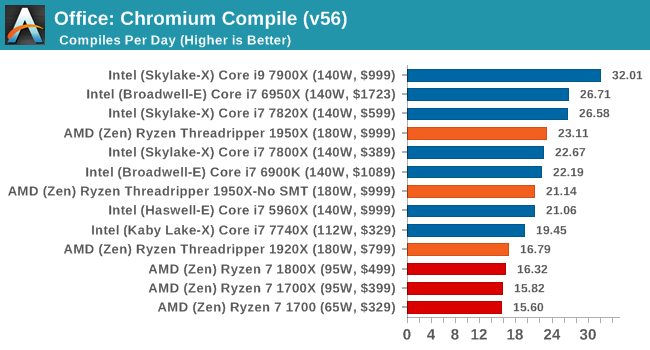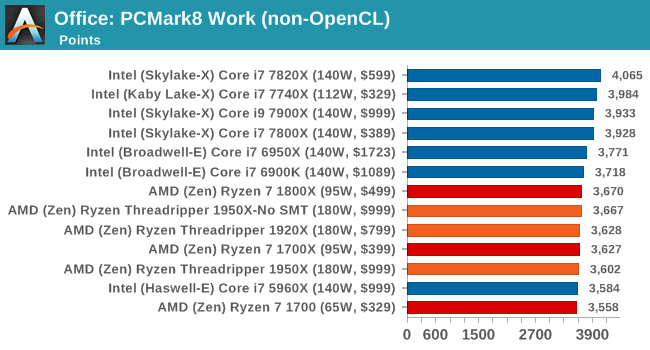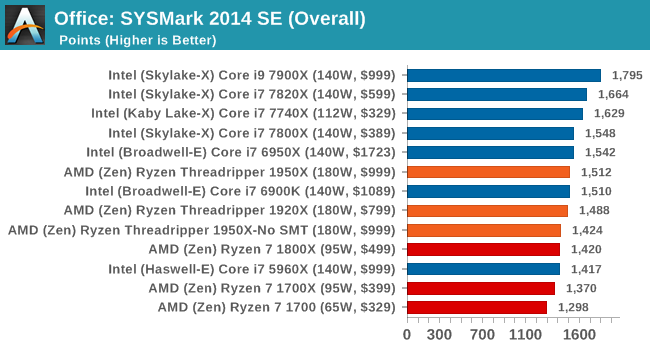The AMD Ryzen Threadripper 1950X and 1920X Review: CPUs on Steroids
by Ian Cutress on August 10, 2017 9:00 AM ESTCPU Office Tests
The office programs we use for benchmarking aren't specific programs per-se, but industry standard tests that hold weight with professionals. The goal of these tests is to use an array of software and techniques that a typical office user might encounter, such as video conferencing, document editing, architectural modeling, and so on and so forth.
All of our benchmark results can also be found in our benchmark engine, Bench.
Chromium Compile (v56)
Our new compilation test uses Windows 10 Pro, VS Community 2015.3 with the Win10 SDK to compile a nightly build of Chromium. We've fixed the test for a build in late March 2017, and we run a fresh full compile in our test. Compilation is the typical example given of a variable threaded workload - some of the compile and linking is linear, whereas other parts are multithreaded.

One of the interesting data points in our test is the Compile, and it is surprising to see the 1920X only just beat the Ryzen 7 chips. Because this test requires a lot of cross-core communication, the fewer cores per CCX there are, the worse the result. This is why the 1950X in SMT-off mode beats the 3 cores-per-CCX 1920X, along with lower latency memory support. We know that this test is not too keen on victim caches either, but it does seem that the 2MB per core ratio does well for the 1950X, and could explain the performance difference moving from 8 to 12 to 16 cores under the Zen microarchitecture.
PCMark8: link
Despite originally coming out in 2008/2009, Futuremark has maintained PCMark8 to remain relevant in 2017. On the scale of complicated tasks, PCMark focuses more on the low-to-mid range of professional workloads, making it a good indicator for what people consider 'office' work. We run the benchmark from the commandline in 'conventional' mode, meaning C++ over OpenCL, to remove the graphics card from the equation and focus purely on the CPU. PCMark8 offers Home, Work and Creative workloads, with some software tests shared and others unique to each benchmark set.


Strangely, PCMark 8's Creative test seems to be failing across the board. We're trying to narrow down the issue.
SYSmark 2014 SE: link
SYSmark is developed by Bapco, a consortium of industry CPU companies. The goal of SYSmark is to take stripped down versions of popular software, such as Photoshop and Onenote, and measure how long it takes to process certain tasks within that software. The end result is a score for each of the three segments (Office, Media, Data) as well as an overall score. Here a reference system (Core i3-6100, 4GB DDR3, 256GB SSD, Integrated HD 530 graphics) is used to provide a baseline score of 1000 in each test.
A note on context for these numbers. AMD left Bapco in the last two years, due to differences of opinion on how the benchmarking suites were chosen and AMD believed the tests are angled towards Intel processors and had optimizations to show bigger differences than what AMD felt was present. The following benchmarks are provided as data, but the conflict of opinion between the two companies on the validity of the benchmark is provided as context for the following numbers.











347 Comments
View All Comments
sorten - Friday, August 11, 2017 - link
Swole? Threadripped?Rottie - Friday, August 11, 2017 - link
AMD Ryzen CPU is not fast enough. Apple is not ready for AMD Ryzen CPU, sorry AMD. I love AMD but I hated Intel even though I have a Skylake based MacBook Pro. :(Deshi! - Friday, August 11, 2017 - link
One small correction, Ryzen has 24 PCIE lanes, not 16. it has 16 for graphics only, but saying only 16 may make people (like me) wonder if you can't run an NVME at x4 and still have the graphics card at 16x, which you totally can do.Deshi! - Friday, August 11, 2017 - link
This is under Feeding the beast section btw, where you said "Whereas Ryzen 7 only had 16 PCIe lanes, competing in part against CPUs from Intel that had 28/44 PCIe lanes,"fanofanand - Tuesday, August 15, 2017 - link
He already answered this question/statement to someone else. there are 20 lanes from the CPU, 16 of which are available for graphics. I don't think his way of viewing it seems accurate, but he has stated that this is how PCIe lanes have been counted "for decades"WaltC - Friday, August 11, 2017 - link
Nice review, btw! Yes, going all the way back to Athlon and the triumph of DDR-Sdram over Rdram, and the triumph of AMD's x86-64 over Itanium (Itanium having been Intel's only "answer" for 64-bit desktop computing post the A64 launch--other than to have actually paid for and *run* an Intel ad campaign stating "You don't need 64-bits on the desktop", believe it or not), and going all the way back to Intel's initial Core 2 designs, the products that *actually licensed x86-64 from AMD* (so that Intel could compete in the 64-bit desktop space it claimed didn't exist), it's really remarkable how much AMD has done to enervate and energize the x86 computing marketplace globally. Interestingly enough it's been AMD, not Intel, that has charted the course for desktop computing globally--and it goes all the way back to the original AMD Athlon. The original Pentium designs--I owned 90MHz and 100MHz Pentiums before I moved to AMD in 1999--were the high-point of an architecture that Intel would *cancel* shortly thereafter simply because it could not compete with the Athlon and its spin-off architectures like the A64. That which is called "Pentium" today is not...;) Intel simply has continued to use the brand. All I can say is: TGF AMD...;) I've tried to imagine where Intel would have taken the desktop computing market had consumers allowed the company to lead them around by the nose, and I can't...;) If not for AMD *right now* and all the activity the company is bringing to the PC space once again, there would not be much of a PC market globally going on. But now that we have some *action* again and Intel is breaking its legs trying to keep up, the PC market is poised to break out of the doldrums! I guess Intel had decided to simply nap for a few decades--"Wake me when some other company does something we'll have to compete with!" Ugh.zeroidea - Friday, August 11, 2017 - link
Hi Ian,On the Civ 6 benchmark page, all results after the GTX 1080 are mislabeled as GTA 6.
Ahmad Rady - Friday, August 11, 2017 - link
Can you try to test this CPU using windows server?This is a MCM CPU looks like 4 CPUs attached to each other.
I think windows 10 Pro can't get the most of this CPU unless we have windows 10 Pro for WS
Pekish79 - Friday, August 11, 2017 - link
Vray has a Rendering Benchmark too maybe you could use bothPekish79 - Friday, August 11, 2017 - link
I went to check both page of Vray and Corona BenchmarkCorona match more or less the graphic and Vray has the following
AMD 1950 : 00:46-00:48 sec
I9 7900: 00:54-00:56 sec
I7 6950: 01:00-01:10 sec
I5 5960: 01:23-01:33 sec